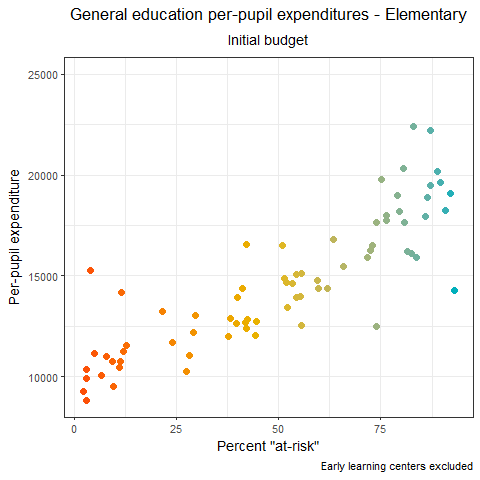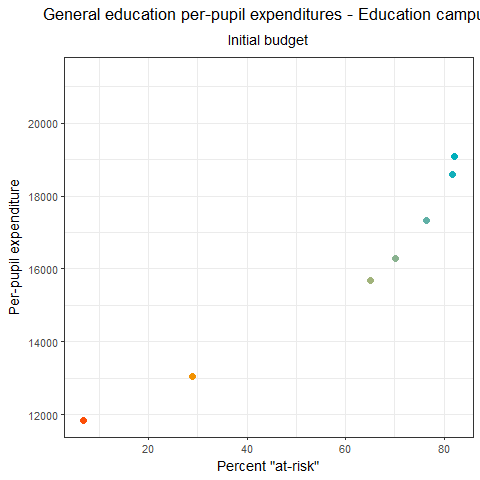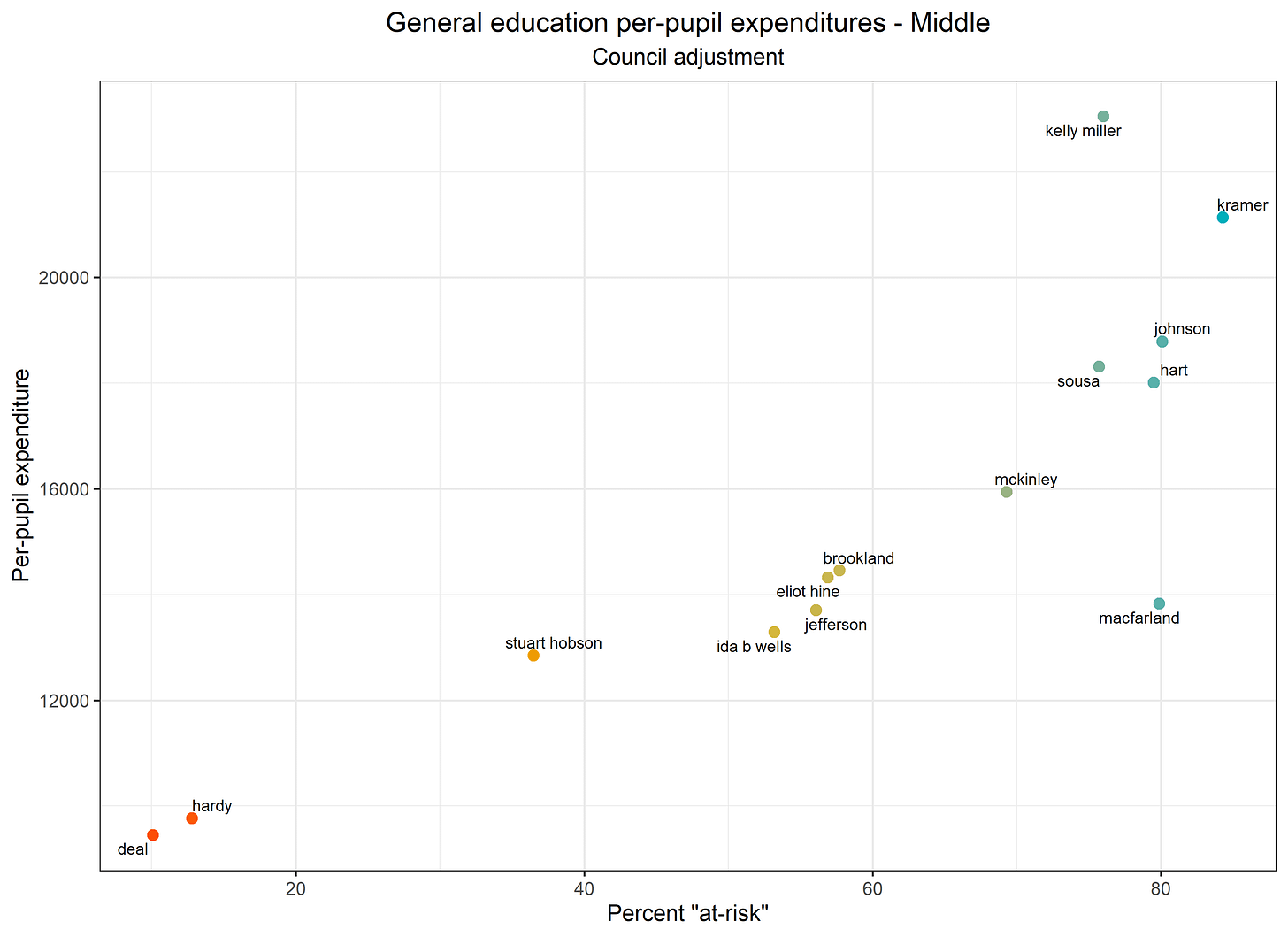Each year, DCPS forces staffing cuts at some schools, and public witnesses spend hours bemoaning these cuts at Council of DC hearings. In response to this problem, the Council of DC passed the Schools First legislation in 2022, which aims to ensure that schools maintain their staff over time, if they have the same number of classes. There was already a law on the books to try to mitigate school budget cuts: Stabilization requires schools to receive at least 95% of its budget from the previous year, but given rising staff costs, this has proven to be insufficient in practice.
Schools First was legislation of political expediency – appeal to everyone with the promise of stability and no more staffing cuts, but not consider the adequacy or equity of existing school budgets, which perhaps would have raised more scrutiny. When we say “hold school budgets harmless”, we are inadvertently saying, “We think schools should be able to keep the resources they have.” But do we really want to say that? Even when parent teacher organizations at some schools raise hundreds of thousands of dollars while others don’t? Even when only schools serving affluent communities have access to certain programming? When initially asked whether I supported Schools First, I said I would rather have inequitable and stable budgets over inequitable AND unstable budgets because those were the only two options offered at the time.
Last year, DCPS completely ignored Schools First and cut staff from school budgets, and the Council redirected funds to schools from DCPS central office. In what appeared to be a decision made out of spite, DCPS responded by cutting from its central office budget what others had long advocated for – updates to technology for students. And again this year, DCPS ignored School First, and Council is in the process of trying to redirect more funding from central office to schools to starve off school staffing cuts. The difference this year though is that the city’s budget is much more strapped, and schools are facing steeper cuts.
DCPS responded in a letter sent yesterday to the Council of DC against the cuts to central office detailing which programs and services would be cut:
Security Services – The proposed $10,505,912 cut would remove 33% of DCPS’ security funding and limit schools’ ability to keep students safe. This funding covers all non-MPD security staff, maintenance for cameras and x-ray machines, access to citywide radios by DCPS police, and other equipment that DCPS and contractors use to ensure student safety. The FY25 proposed amount in the Mayor’s budget was already $5 million dollars less than FY23 actual costs; this further reduction is equivalent to over 200,000 fewer hours of security services. If this cut is maintained, DCPS would be forced to reduce more than 100 security officers – resulting in most campuses losing at least one security officer during the school day, in addition to reducing free security provided to partners such as after school programs and limiting security for programs outside of the school day such as on nights and weekends.
Food and Nutrition Services – The proposed $4,123,937 cut would require DCPS to reduce meals for afterschool activities. A cut of this magnitude is equivalent to over 600,000 student meals. School meals are a vital factor in students' health, wellness, and engaged learning. The proposed cut could also limit DCPS’ ability to maintain kitchen and other food service equipment.
Attorneys’ Fees – The proposed $3,617,334 cut would limit the ability of the District to pay court-imposed fees associated with settlements in lawsuits brought against the District. The Office of the Chief Financial Officer requires $5 million of funding for this budget but the proposed cut would reduce this budget to $1.4 million.
Technology Support – The proposed $3,000,000 cut would limit DCPS’ ability to improve Wi-Fi services at schools, reduce DCPS teachers and parents' access to the student information system for grades, assignments, and record keeping, and remove funding for TurnItIn software that prevents plagiarism.
Mathematics Training for Teachers – The proposed $2,399,826 cut would eliminate the DREAM Math Center. This cut would mean that DCPS could not begin new training programs for math teachers or engaging content for families related to math. The DREAM Math Center is designed from the model of the highly effective DC Reading Clinic but focused on mathematics instruction. The DREAM Math Center is a core strategy for improving student outcomes in math, a district priority.
Alternative Education Program – The proposed $1,611,509 cut would eliminate this program. This cut would mean DCPS could not begin an alternative pilot program for students who require a significantly higher level of support due to serious safety concerns, including students who bring firearms to school.
Learn to Swim Program – The proposed $783,704 cut would eliminate the 3rd Grade Swim Program. Currently, 63 of 86 elementary schools (79%) and over 2,500 third grade students participate in the program.
Connected Schools Support – The proposed $520,622 cut would eliminate centrally funded support for Connected Schools. Connected Schools are DCPS’ community schools model. This cut would shift costs for services like food pantry access or mental health support onto school budgets.
Employee Clearances – The proposed $464,858 cut would eliminate over 80% of the funding DCPS uses to pay for its personnel hiring and management software and for compliance with required clearances. Schools use this software to screen, interview, and select staff for vacancies.
Substitutes and Other Position Costs – The proposed $452,029 cut to schools reduces the amount of funding to support credentialing personnel in schools, covering substitute costs, and providing IMPACTplus bonuses and other teacher stipends.
Services for Students Experiencing Homelessness – The proposed $366,980 cut would eliminate academic enrichment resources for students experiencing homelessness or who are designated at-risk.
MacArthur Supplies and Materials – The proposes $290,218 cut would eliminate necessary supplies for MacArthur High School like additional textbooks, science lap equipment, and curriculum materials as our newest high school continues to expand. These expenses are not capital eligible.
Graduation Venues – The proposed $266,728 cut would eliminate funding to pay for large graduation venues. Without this funding, schools would either need to provide their own funding for venues or hold ceremonies on campus, which would limit attendance, especially for large schools.
Early Childhood Mathematics Curriculum – The proposed $125,000 cut would eliminate training for early childhood educators in DCPS’ new mathematics curriculum. This training would support teachers in improving student proficiency in mathematics, an area of focus for the district.
Some proposed cuts are concerning to me, including the cuts to food services (afterschool meals) and the learn-to-swim program for students in underserved communities. Yet DCPS’s history of not being a good faith actor when it comes to budget transparency makes it hard to know what to advocate for.
Everyone wants school stability. But if we go with the Council’s markup, we’re simultaneously advocating for increasing school budgets in some schools serving disproportionately few “at-risk” students while cutting food and swimming programs for students at underserved schools. I don’t want to co-sign that. Do you?
Obviously staffing cuts are very difficult for schools to bear and unravel the fabric of school communities, some of which are already fragile due to the aftermath of covid-19. I’ve personally experienced what it’s like to have multiple staff cut from my children’s school budget with no warning at all. But holding school budgets harmless without regard for the adequacy or equity of budgets is a bad idea.
These animations show the initial, submitted, and proposed Council per-pupil (general education) expenditures for DCPS schools. In the proposed Council versions, the dots get farther apart and appear less fair for schools serving similar student populations and less equitable for schools serving different student populations. Some schools do need higher levels of funding, however, to account for things like greater preschool enrollment, which increases costs due to smaller class sizes.
Where do we go from here? Unfortunately, it’s complicated and messy. If it were me, I’d look at school budget stability along with adequacy and equity. And then I’d pick the option that optimized all three while considering cuts to central office as part of that equation. I would also ask teachers and principals where cuts may be warranted in central office. And while I think we could do possibly better in the short term, we will continually be choosing among bad options without structural changes and dealing with root causes of inequity.
The Council of DC has propped up Schools First as a way to guard against staffing cuts due to declining enrollments in underserved schools. Yet Schools First doesn’t fully protect schools from declining enrollments. Moreover, to date, the Council of DC has been unwilling to address the root causes for declining enrollments in underserved schools: misuses of “at-risk” funds since their inception (they have not been fully supplemental as intended), no controls or restrictions for new schools opening in underserved communities, no funding to account for midyear mobility, and so on. To do better in the long game, we are going to have to deal with root causes of inequity as well as say the quiet parts out loud.











